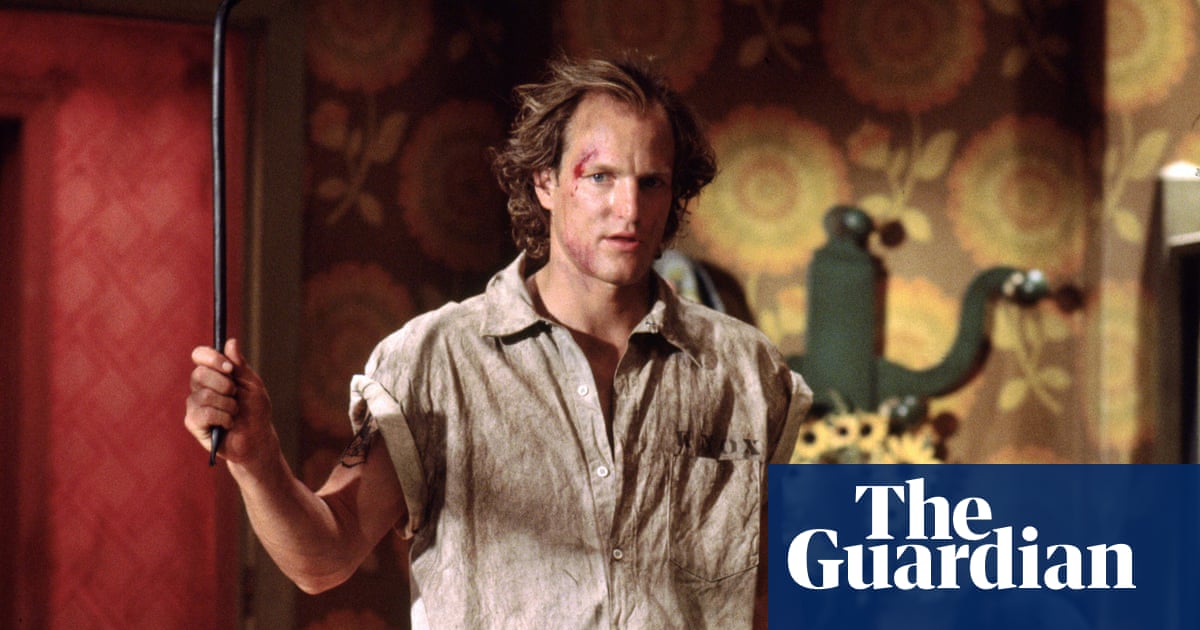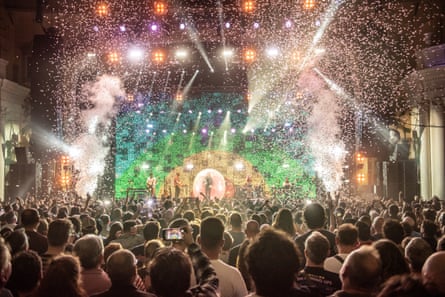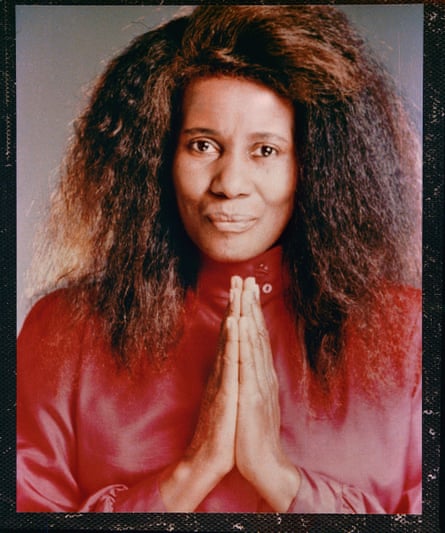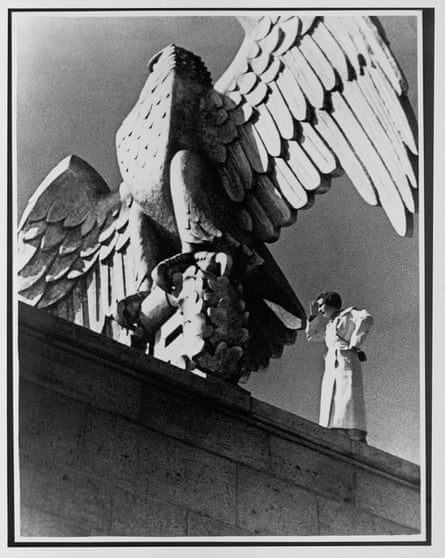
By way of introduction, Oliver Stone’s Natural Born Killers offers grainy, black-and-white images of the arid south-west that flicker disjointedly to a red tint. There are cuts to eagles and rattlesnakes, and one of those rusty diner signs that are the ultimate cliche of America in decline. Flipping television channels juxtapose Richard Nixon with Leave It to Beaver, and the canted camera angles make it seem like the cinematographer Robert Richardson, known for his hot-white overhead lights, worked in close collaboration with a seesaw. Slathered over all this nonsense is Leonard Cohen’s Waiting for the Miracle.
Welcome to the longest two hours of your life.
When it came out 30 years ago, Natural Born Killers was a shake-and-bake controversy magnet, crudely calibrated to attract the same cultural firestorm it portends to dissect. If there were a way for the film to edit itself into one of its rapid-fire montages of violent, media-driven fiascos, surely Stone would have done it. Handing the least-subtle American director material this inherently combustible is like supplying an arsonist with a cache of TNT. Stone got the public outcry and editorials he wanted – and a rash of NBK-inspired shootings he didn’t – but his lobotomized Badlands is close to unwatchable, a ceaseless barrage of visual effects in support of the same point about the collision of violence, media and celebrity. Each of the nearly 3,000 edits hits like a ball-peen hammer.
It’s hard to guess exactly what Natural Born Killers would have looked like had a young Quentin Tarantino, the author of the original screenplay, secured the meager budget he wanted to direct it. There’s no doubt some controversy would have trailed that film, too, though Tarantino’s long takes and aversion to overt politicking makes it obvious enough that he’d have gone in a much different direction. After Stone and his co-writers, David Veloz and Richard Rutowski, did their own draft of the script, Tarantino’s voice was so minimized that he was reduced to a story credit instead and has not been shy over the years in expressing his distaste for the film. Save for a lead character mulling over a diner order in the opening scene (“Let’s give that key lime pie a day in court”), the wit and color of his dialogue is scrubbed away with steel wool.
That opening sequence sets the table for many such scenes to come: In the middle of a tabloid-friendly killing spree that has them tearing through the New Mexico desert, Mickey (Woody Harrelson) and his wife, Mallory (Juliette Lewis), opt to get violent on the poor rednecks who harass Mallory on the dance floor, not recognizing the couple as notorious outlaws. Stone shoots the ensuing bloodbath by toggling between black-and-white and hyper-saturated color, emphasizing the couple’s gleeful sadism (Mallory uses “eeny-meeny-miny-moe” to choose a victim) while casting them as road-movie romantics, with La Vie en Rose cranked on the soundtrack. In the end, they leave one person alive to tell the story, conscious of their own evolving mythology. They expect to die as legends.
In one of the film’s most repulsive stretches, Stone fills in the backstory by presenting a teenage Mallory’s home life as a parody of the sitcom I Love Lucy, with a laugh track slathered over scenes of verbal, physical and sexual abuse at the hands of her oafish father, played by Rodney Dangerfield in a grease-stained wife-beater. When Mickey turns up in a bloodied butcher’s frock with 50lbs of artery-clogging beef, it’s love at first sight for Mallory, who follows him out the door and later cheers him as he murders her parents. “We got the road to hell in front of us,” Mickey tells Mallory after arranging an impromptu wedding ceremony on a bridge. Their marriage isn’t official, but they’re destined not to survive much longer than the paperwork anyway.
Given Stone’s eagerness to expand Natural Born Killers into an indictment of society at large, Mickey and Mallory are only two faces in the gallery of grotesques swept up in this media event. Sporting an Australian accent that seems acquired from half-awake viewings of the Crocodile Dundee movies, Robert Downey Jr plays the hirsute host of American Maniacs, a true-crime documentary series that’s done segments on serial murderers like Ted Bundy and Charles Manson, but targets Mickey and Mallory as an unprecedented ratings bonanza. On the law and order end of things, Tom Sizemore stars as a sleazy detective with his own yen for strangling women and Tommy Lee Jones is a Texas warden fit for a Roger Corman exploitation picture.
To paraphrase Pee-Wee Herman, there’s an “I meant to do that” defense of the maximalist overload that Stone deploys to such grinding effect, which confronts viewers with so much audiovisual information that they become numb and desensitized to it. When Mickey and Mallory’s exploits are inevitably wedded to ripped-from-the-headline media horrors like the Waco siege, the airing of the OJ Simpson and Menéndez brothers murder trials, and even the Tonya Harding case, it’s a signal that we were immersed in the couple’s world before we ever made their acquaintance. The hectic provocation of Stone’s conceit also includes clips that trickle into the film through TVs and rear projection, from the Coca-Cola polar bear commercials to Leni Riefenstahl’s Nazi propaganda film The Triumph of the Will. (The Coca-Cola Company wasn’t pleased to be included, for obvious reasons.)
There’s a compelling time-capsule quality that’s baked into Natural Born Killers, which strives so hard to plug into the zeitgeist that it’s pristinely carbon-dated to the middle of Bill Clinton’s first term in office. For anyone looking to take stock of American culture in the early to mid-90s, Stone lays a lot of those tensions and anxieties bare, along with the parasitic relationship the tabloid media has with society’s worst and most violent actors. You can’t miss any of the points Stone is trying to make here. You can, however, question whether point-making has much of a relationship with good art.
Source: theguardian.com





















